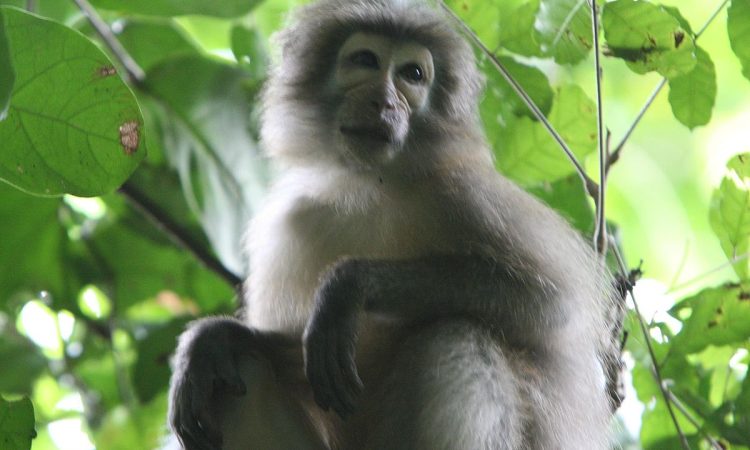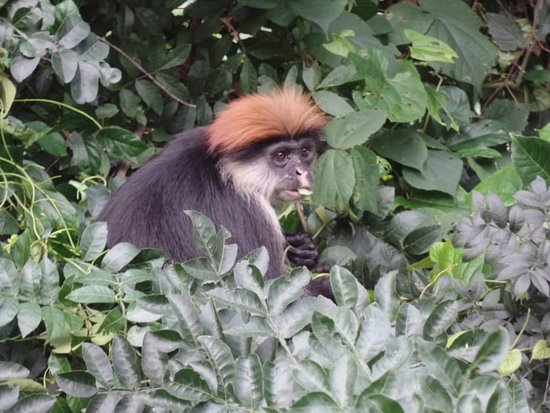The unique Udzungwa red colobus and sanje mangabey : The Eastern Arc Mountains’ Udzungwa Mountains National Park spans 1,990 square kilometers (770 square miles) (which comprise mountain ranges from the Taita Hills in southern Kenya to the Makambako Gap in south-central Tanzania). The park, which includes hills with elevations ranging from 250 meters (820 feet) to the park’s highest point, Lohomero peak, at 2,576 meters (8,451 feet), is sometimes referred to as a “African Galapagos” for the distinctiveness of its wildlife. Kilombero District and the eastern Njombe Region both share a border with the park. The park’s habitat includes grassland, steppe, mountain forest, tropical rainforest, and miombo woodland. The park has the distinction of housing 30–40% of Tanzania’s plant and animal species. 6 species of primate and more than 400 bird species are reported from the park. It boasts the second-highest biodiversity of any African national park. It is one of the 34 “World Biodiversity Hotspots” on the list. It is one of the 200 WWF Ecoregions of Critical Global Importance, according to the list. Five of the six recorded species of primates are endemic. Only the Udzungwa Mountains National Park is home to the Sanje mangabey, which was only recognized as a separate species in 1986, and the Udzungwa red colobus.

Udzungwa red colobus monkey
The Udzungwa red colobus, also referred to as the Iringa red colobus or Piliocolobus gordonorum, is a species of primate in the Cercopithecidae family. It is unique to Tanzania’s Udzungwa Mountains’ riverine and montane forests.
The Udzungwa red colobus is native to southern central Tanzania, where it is located in the Udzungwa Mountains. These mountains have the greatest intact forests in the Eastern Arc mountain group and a remarkable high vertebrate diversity. This area’s miombo woodlands, moist lowland forests, and montane forests, including the 1,990 km2 Udzungwa Mountains National Park and several nearby forests, many of which have nature or forest reserve status, are home to the red colobus.
It is estimated that there are between 30,000 and 40,000 members of this species’ entire population, the majority of whom live in the national park. This species is more common in low-elevation woods than in forests at high altitudes. However, some of the small lowland woods in the Kilombero Valley that are not part of the national park have recently been seriously harmed or lost entirely. The only remaining healthy population of red colobus monkeys is found in Magombera Woodland, which was once home to several forest patches around the eastern base of the Udzungwa Mountains.
Sanje Mangabey monkey
The Sanje mangabey (Cercocebus sanjei), a member of the white-eyed mangabey family from Tanzania‘s Eastern Arc Mountains, is a critically endangered Old World monkey. They are a greyish color and range in length from 50 to 65 centimeters (20 to 26 inches), not including the tail. About 70% of their diet is fruit. Because they spend most of their time on the ground and inhabit valley woods and mountain slopes, they are vulnerable to poaching and killing.

The medium-sized Sanje mangabey has a similar appearance to both sexes, albeit males are slightly bigger than females. The skin on the remainder of the face is pinkish or greyish, with a pale bluish border at the hairline, whereas the snout is grey. Particularly pale features include the eyelids and the under-eye region. The hair on the crown tends to have a parting or little whorl and is longer than the hair elsewhere. The shafts and bases of the hair on the crown and widow’s peak are grayish-brown. Creamy grey bases and darker grey shafts with bands of yellowish-orange and black at the tips make up the hair on the back, flanks, and limbs. The underparts have long, light yellowish-orange hairs. The hands and feet are dark grey, as are the tips of the limbs. The ischial callosities are pink, and the exposed skin beneath the tail is bluish-grey with pink undertones. The tip of the long, grey tail features a tuft of longer hairs. The diurnal Sanje mangabey spends almost half of its time on the ground and the other half foraging in the upper, medium, and understory of trees. Mangabey groups live in a home range and spend the night in one of the about eight clusters of tall trees they frequently use as a sleeping area. Before the flock departs to go foraging in the morning, these trees frequently produce a loud “whoop-gabble” sound. They spend some time on the ground looking for fallen fruits, seeds, and nuts, as well as ants and other invertebrates, roots, and fungi. They also spend some time in the canopy eating fruits and seeds. Figs, the Parinari excelsa stones, and other substantial or robust objects are often stored in cheek pouches, being cracked open later with the help of strong premolar teeth, The unique Udzungwa red colobus and sanje mangabey.
Two conservationists were on a field trip in the Udzungwa Mountains in Tanzania in 1979 when they heard an animal they recognized as a mangabey, a monkey not previously known from these mountains, making its call. They discovered after additional investigation that an unidentified species of mangabey was involved—the first new primate species to be detected in East Africa in many years. Russell Mittermeier, an American primatologist, first identified the species in 1986 and gave it the scientific name Cercocebus sanjei.
You are cordially invited to visit Udzungwa National Park to observe the rare Udzungwa Red Colobus Monkey and Sanje Managbey Monkey. These creatures can only be found in Tanzania. It is very good to see them, and you must be able to learn a lot from them.


